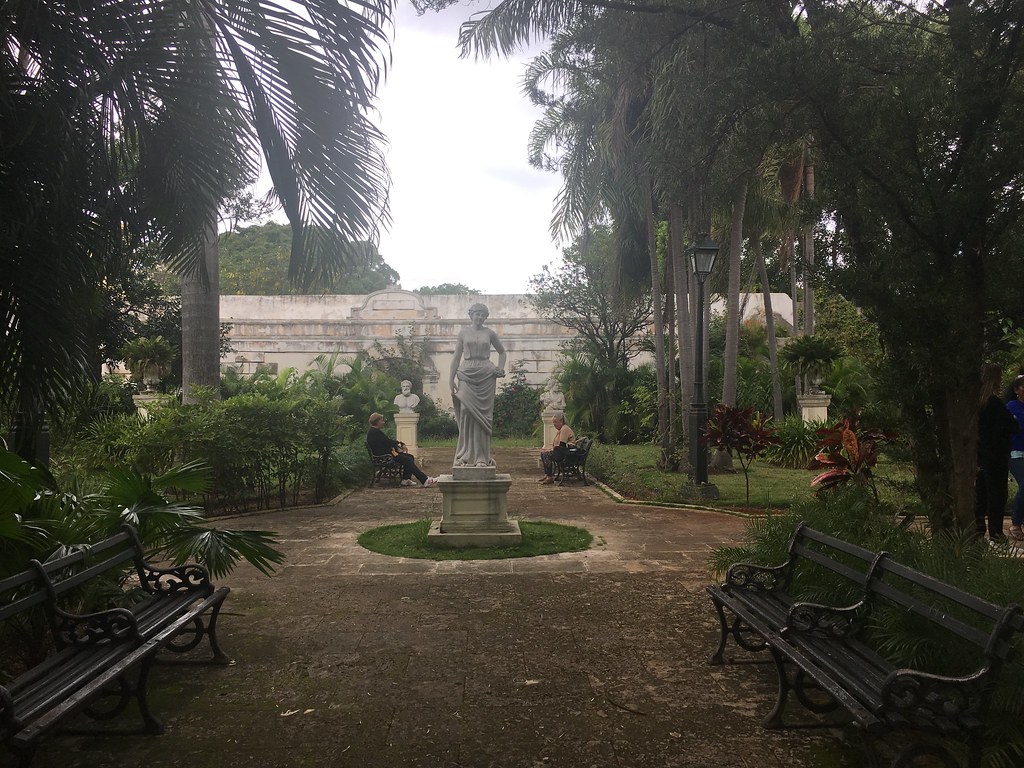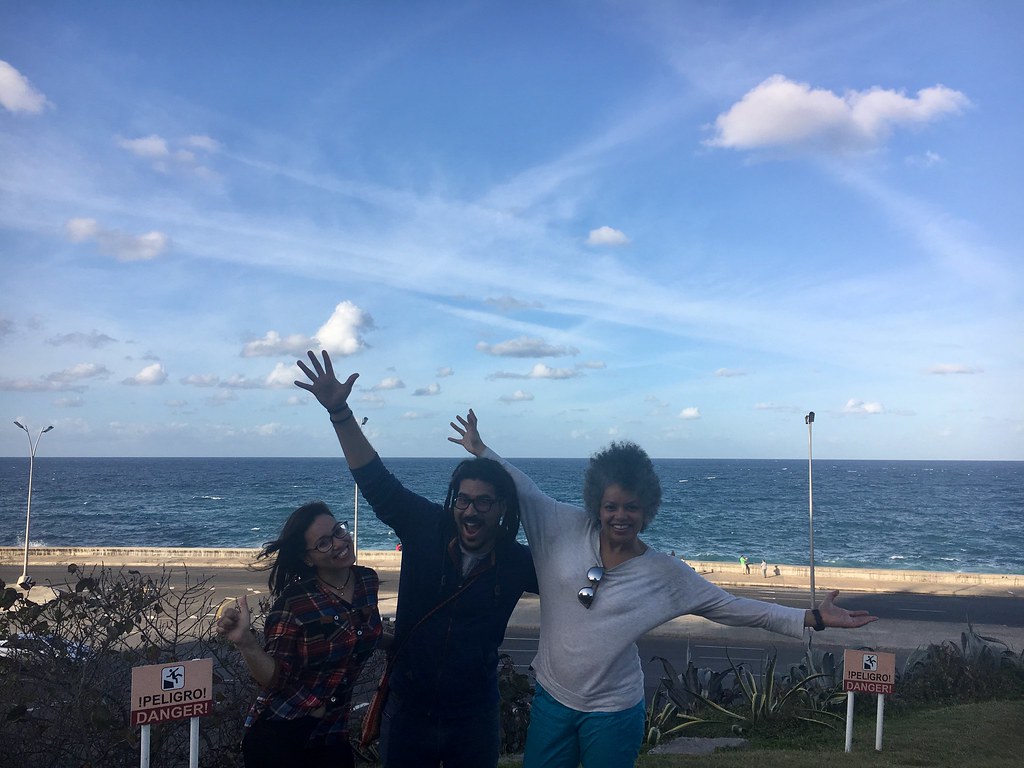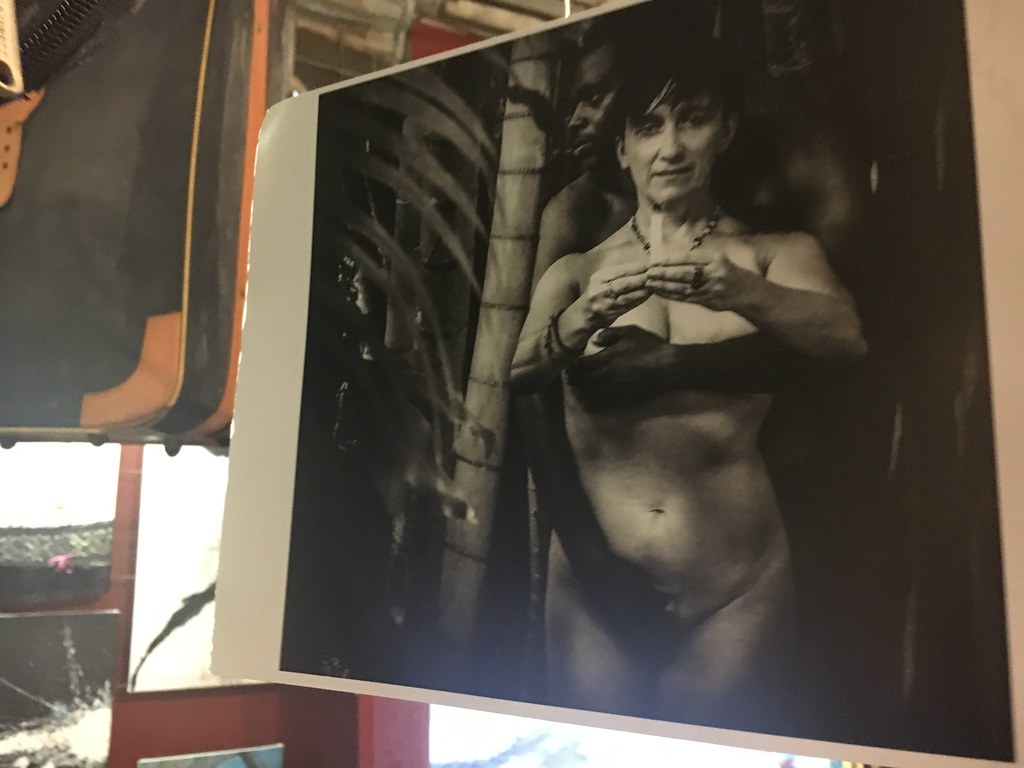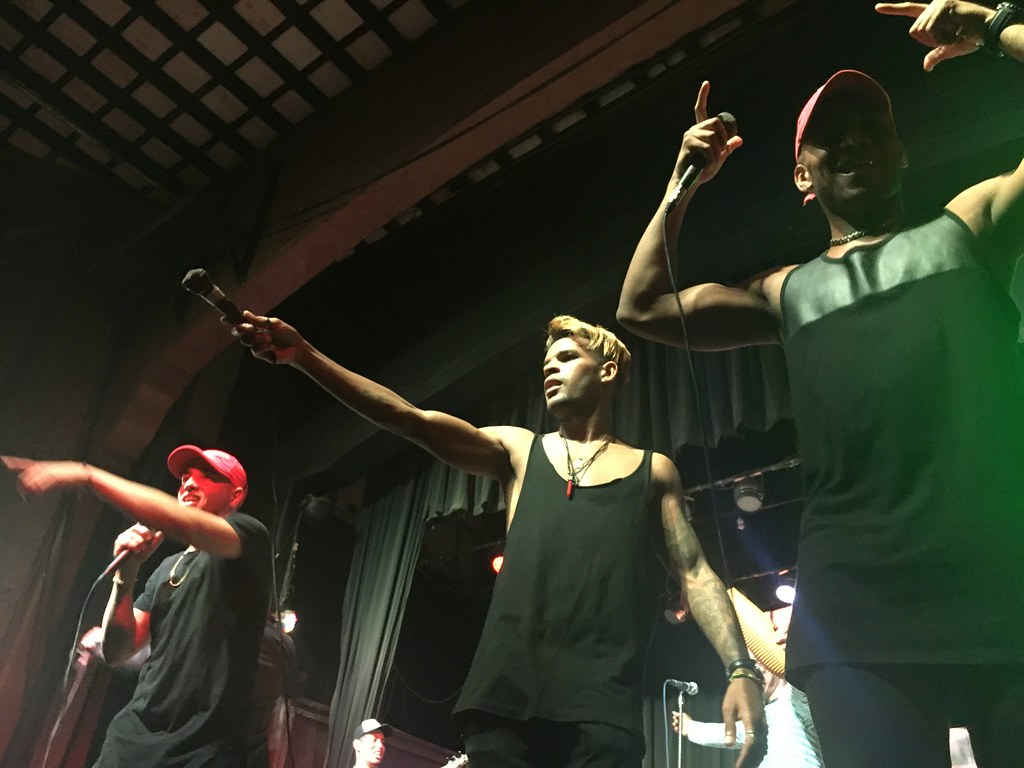By my third day in Cuba, I was feeling optimistic. I had made three attempts to get on the Internet and one of them was successful. I had also found an eerie and magical park near my B&B, called Quinta de Molinos. It reminded me of similar decadent walled estates in Portugal, that testify to the deep inequalities of the colonial empires. You step out of the dusty, concrete cacaphony of Havana’s urban highways, through guarded gates, into a green tropical paradise about eight city blocks in extent.

The Quinta contains a ruined summer Palace, an educational institution, an aviary and various smaller buildings. Like the rest of Havana it has quite the faded grandeur. There are towering palms and figs, statues and busts, ponds linked with bridges and crowned with gazebos.
You might expect such an urban lung to be popular with tourists and locals – but most of the visitors I saw that day were students with Downes Syndrome on an excursion. When I asked the guardian at the gate about the opening hours he told me that the Quinta was closed: only open Thurs to Sunday. I dared not ask any more questions in case they told me that I had to leave. Perhaps they thought I was one of the minders of the students. At least this estate is now in public hands even if it's not always open.
When I got back to my B&B there was a call for me from Pablo. He was coming over with his girlfriend to take me dancing. There was also a call from Lou. I invited her to join us, but she didn't have time for a whole evening of partying. I grabbed a bite to eat from the fridge and meditated. I relaxed happily in the hammock on my leafy patio, looking forward to meeting my new friends, Pablo and Vanessa. A Cuban friend from Madrid had introduced me to Pablo online, so this would be our first face to face encounter.
Vedado with Vanessa and Pablo
I was having pizza in the restaurant downstairs when Pablo and Vanessa came to collect me. We greeted each other with kisses and spoke a mix of Spanish and English. They were neatly dressed in a bohemian hipster style. Pablo is a very tall, well built man man with latte-coloured skin, a goatee and dark hair in dreadlocks about collar length. He wore a hoody, T-shirt and jeans with boots. Petite and slender, Vanessa wore black leggings with a clingy plaid blouse. She has bright skin, lively dark eyes and black, straight hair cut in a bob. The couple met in teacher training school. Vanessa teaches Latin, Spanish and French. Pablo edits educational publications.Curious and open-minded, the couple spoke of their ambitions to travel and how difficult it is to save money to do it. Some Cubans now living overseas got their opportunity to travel through educational exchanges with the few countries in the world that invite Cubans. For our mutual friend Nori who I met in Spain, Angola was the gateway to the world. I learned that the average Cuban national wage is about 24 CUC (about €24) per month. The main cost is food, because accommodation is essentially free and utilities very cheap. The electricity bill for a large house might reach €6 per month. Even so, this leaves most Cubans with almost no disposable income. Tourism-related jobs often pay much more than university-graduate work or professions.
Tourists have to pay higher prices for events and many other things, and lack the local knowledge, queueing time and subsidies required to live cheaply. As a tourist, I easily would spend €24 a day in Havana just on food, drinks, transport and music, and the same again on my accommodation. If I was paying for tour guides, the cost would be even higher.
Vanessa and Pablo educated me in Cuban history as we stood outside the University, and we found that our values were well aligned. We strolled around Vedado, which has replaced Havana Vieja as the living commercial and cultural heart of the city. On the main street, Calle 23, the architecture looks like unrenovated 1950’s to 1970’s era, with facades of degraded concrete and faded plastics. We stopped by the popular ice cream bar, Coppelia, but the queue was too long for my impatient ways. So we picked up ice cream somewhere else and visited the famous Hotel Nacional for the view of the sea.

I told my friends how I was disappointed I had been on first sight of Malecon waterfront. Besides the nice wide sea wall, there’s nothing to see but a highway. The couple told me that there used to be natural ocean pools and man-made baths – this used to be a popular bathing area. Now swimming and bathing is forbidden and there's nothing there but a grey, loud highway. This is what I call the American nightmare. "Que pena! Que triste!" I lamented.
Art and live Cuban salsa
From Malecon we caught a taxi collectivo into the city. We took a brief stroll down a narrow bustling street into a fascinating art studio and gallery called The Eye of the Storm. The most of the art was figurative oil painting and mixed media sculptures made from found objects such as suitcases, broken dolls, plastic pipes, vehicle parts. You could imagine these objects being torn and thrown from their right place and reassembled by the storm. The storm itself was a recurring visual motif. The gallery itself was an art installation... one corner had keyboard and a bar, upholstered benches and a wooden table in the shape of an artists pallette.
At the top of the narrow staircase was a display of colourful watercolour paintings. There was also some great photography in black-and-white: nudes and character portraits. A grubby weights bench press sat incongruously in a dark corner beside an abstract, headless, life-size crucifix made of leather and wood, hung with a pair of female breasts in white plastercast.
Our plan was next to take a boat ('lancha') across the harbour, but we ran into some friends of Pablo and Vanessa who advised us that we would miss the salsa show later on if we took the boat now. They were keen dancers themselves so we arranged to meet them the next day for a Kizomba social. To get to the salsa show, we had an epic crosstown collectivo cab ride to the sound of booming reggaeton. Our destination was Casa de Musica, in a district west of Vedado called Miramar.
We arrived in good time for the band but the cover charge was heavier than expected. We almost walked away... but there was no other entertainment in this suburban barrio. The band and venue looked promising and Vanessa reminded me that I had come here to dance. I decided to treat my new friends and myself to some live Cuban music, and dance with a well-heeled Cuban crowd far from the tourist traps. We got in to the crowded venue in time to take the last table, right under the stage.
The 16 piece all-male band came on at 19:00 sharp. About five guys on vocals fronted the band, and they took turns singing solo. They also danced and performed backing vocals for each other. The big band included horns, keyboards, electric bass, classic Afro Cuban percussion: congas and a small handheld instrument. Most of the musicians were of Afro-Caribbean appearance, in various beautiful shades of brown – a feast for the eyes as well as the ears. All were dressed in black, mostly urban: tight torn jeans or sportswear. An older singer wore a shiny black suit with tight pants cut above the knee to reveal smooth chocolate brown legs. This all-black stage uniform intensified the macho atmosphere of the band, and contrasted with the joyful colour and energy of their music and dance.

We pushed back the chairs to dance during the first song. We delighted in copying the dancers on stage in our own little jam circle. Within a few songs the whole crowd were on their feet. The ages ranged from 20s upward with groups in their 50s and 60s who looked to be enjoying life very much. It was not a social dancing crowd – couples stuck with their partners. By their flamboyant style and dark skin, most of the crowd looked like Afro Caribbean locals, with the exception of a few young blonde tourists, dancing next to us, close to the stage.
If you believe in love...
As well as plenty of cracking tunes for dancing, the band played one or two slow numbers. I sat down to rest my legs, and my friends soon joined me. The front man in the shiny black suit with the tight shorts chanted,"If you believe in love, lift your hands up!"
Being told how to dance by the people on stage gets boring – and this was to cheesy by far.
"If you believe in love, lift your legs up!" I joked. Laughing, we rocked back in our chairs and and kicked our legs up towards the stage.
Casa de la Musica was totally worth it – an exhilarating experience. I am accustomed to high quality music from around the world – in that respect it was no different from many gigs I've been to. But the crowd of locals were interesting, the energy of the band was impressive, and my two friends were mighty craic. The band wrapped up about 20:45 and the audience poured out into the suburban street. I was ready to go home, sore from the dancing and the day's exploration on foot. Pablo and Vanessa took good care of me, accompanying me to my door, although they live quite far away. Without my kind Cuban friends, it's hard to imagine how I would have enjoyed the big city. Muchas gracias Vanessa, Pablo y Lou!

Comments